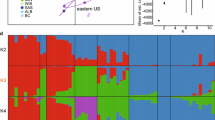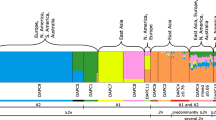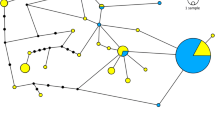Abstract
Phytophthora infestans causes late blight, a devastating disease of potato and tomato. Previous work in the Netherlands showed that the population is highly diverse due to sexual reproduction and that oospores can overwinter in the soil. We sequenced archived DNA from multiple nuclear and mitochondrial loci from P. infestans sampled in 1994 from 17 conventional and 5 organic potato fields and 7 potato refuse pile sites in the Southern Flevoland. We assessed the genealogical history using sequences from two regions of the single-copy nuclear ras gene (intron 1 and exons 3–6) and several mitochondrial loci (P3-rpl14, rpl5 and tRNAs and P4-cox1) from 83 isolates. There were 10 heterozygous sites in the ras gene and 12 in the mitochondrial genes that were phylogenetically informative. Five nuclear and 5 mitochondrial haplotypes were shared among fields and several unique haplotypes were found. Nucleotide diversity and population mean mutation rates (θW) were higher in samples from refuse piles and organic fields than conventional fields for both nuclear and mitochondrial loci. Subdivision was observed between conventional fields and refuse piles. Migration analysis suggested that gene flow may have occurred first from conventional potato fields to organic fields and then to refuse piles. Recent mutations were found in rare lineages from organic fields. Ancestral mutations in mitochondrial loci were derived from samples from refuse piles documenting the importance of refuse piles as a source of inoculum for late blight epidemics in the organic and conventional fields.


Similar content being viewed by others
References
Avila-Adame C, Gómez-Alpizar L, Buell RC, Ristaino JB (2006) Mitochondrial genome sequencing of the haplotypes of the Irish Potato famine pathogen, Phytophthora infestans. Cur Gen 49:39–46
Aylor DL, Price EW, Carbone I (2006) SNAP: combine and Map modules for multilocus population genetic analysis. Bioinformatics 22:1399–1401
Bahlo M, Griffiths RC (2000) Inference from gene trees in a subdivided population. Theor Pop Biol 57:79–95
Bonde R, Schultz ES (1943) Potato cull piles as a source of late-blight infection. Maine Agric Exp Sta Bull 20:112–118
Bouws H, Finckh MR (2007) Effects of cropping history and origin of seed potatoes on population structure of Phytophthora infestans. Eur J Plant Pathol 117:313–327
Boyd AEW (1974) Sources of potato blight (Phytophthora infestans) in the east of Scotland. Plant Pathol 23:30–36
Chen Y, Roxby R (1996) Characterization of a Phytophthora infestans gene involved in vesicle transport. Gene 181:89–94
Cooke DEL et al (2012) Genome analyses of an aggressive and invasive lineage of the Irish potato famine pathogen. PLOS Pathogens 8 e1002940(10):14
Couzens BJ, Evans E (1968) The spread of potato late blight (Phytophthora infestans) within the crop. Trans Brit Mycol Soc 51:461–467
Day JP, Shattock RC (1997) Aggressiveness and other factors relating to displacement of populations of Phytophthora infestans in England and Wales. Eur J Plant Pathol 103:379–391
Dorn B, Musa T, Krebs H, Fried PM, Forrer HR (2007) Control of late blight in organic potato production: evaluation of copper-free preparations under field, growth chamber and laboratory conditions. Eur J Plant Pathol 119:217–240
Drenth A, Goodwin SB, Fry WE, Davidse LC (1993) Genotypic diversity of Phytophthora infestans in The Netherlands revealed by DNA polymorphisms. Phytopathology 83:1087–1092
Drenth, Turkenstee LJ, Govers F (1993) The occurrence of the A2 mating type of Phytophthora infestans in The Netherlands; significance and consequences. Netherlands J Plant Pathol 99:57–67
Drenth A, Janssen EM, Govers F (1995) Formation and survival of oospores of Phytophthora infestans under natural conditions. Plant Pathol 44:86–94
Finckh MR, Schulte-Geldermann E, Bruns C (2006) Challenges to organic potato farming: disease and nutrient management. Pot Res 49:27–42
Fry WE (2008) Phytophthora infestans: the plant (and R gene) destroyer. Mol Plant Pathol 9:385–402
Fry WE, Drenth A, Spielman LJ, Mantel BC, Davidse LC, Goodwin SB (1991) Population genetic structure of Phytophthora infestans in The Netherlands. Phytopathology 81:1330–1336
Fu YX (1997) Statistical tests of neutrality of mutations against population growth, hitchhiking and background selection. Genetics 147:915–925
Fu Y-X, Li W-H (1993) Statistical tests of neutrality of mutations. Genetics 133:693–709
Gómez-Alpizar L, Carbone I, Ristaino JB (2007) An Andean origin for Phytophthora infestans inferred from nuclear and mitochondrial DNA sequences. Proc Nat Acad Sci, USA 104:3306–3311
Griffith GW, Shaw DS (1998) Polymorphisms in Phytophthora infestans: four mitochondrial haplotypes are detected after PCR amplification of DNA from pure cultures or from host lesions. Appl Envir Micro 64:4007–4014
Griffiths RC, Tavaré S (1994) Ancestral inference in population genetics. Stat Sci 9:307–309
Hall TA (1999) BioEdit: a user-friendly biological sequence alignment editor and analysis program for Windows 95/98/NT. Nuc Acids Sym Series 41:95–98
Hansen JG, Lassen P, Rohrig M (2001) Monitoring of potato late blight based on collaborative PC- and internet applications. Proceedings of the Workshop on the European Network for Development of an Integrated Control Strategy of Potato Late Blight PAV Special Report 7:39–54
Haverkort AJ, Boonekamp PM, Hutten R, Jacobsen E, Lotz LAP, Kessel GJY, Visser RGF, van der Vosson EAG (2008) Societal costs of late blight in potato and prospects for durable resistance through cisgenic modifications. Pot Res 51:47–57
Haverkort AJ, Struik PC, Visser RGF, Jacobsen E (2009) Applied biotechnology to combat late blight in potato caused by Phytophthora infestans. Pot Res 52:249–264
Hey J, Nielsen R (2004) Multilocus methods for estimating population sizes, migration rates and divergence time, with applications to the divergence of Drosophila pseudoobscura and D. persimilis. Genetics 167:747–760
Hirst JM, Stedman OJ (1960) The epidemiology of Phytophthora infestans. II The source of inoculum. Ann Appl Biol 48:489–517
Hohl HR, Iselin K (1984) Strains of Phytophthora infestans with A2 mating type behavior. Trans Brit Mycol Soc 83:529–530
Hu CH, Perez FG, Donahoo R, McLeod A, Myers K, Ivors K, Secor G, Roberts PD, Fry WE, Deahl KL, Ristaino JB (2012) Recent genotypes of Phytophthora infestans in eastern USA reveal clonal populations and reappearance of mefenoxam sensitivity. Plant Dis 96:1323–1330
Hudson RR, Boos DD, Kaplan NL (1992) A statistical test for detecting geographic subdivision. Mol Biol Evol 14:474–484
Hudson RR, Slatkin M, Maddison WP (1992) Estimation of levels of gene flow from DNA sequence data. Genetics 132:583–589
Kimura M (1980) A simple method for estimating evolutionary rate of base substitutions through comparative studies of nucleotide sequences. J Mol Evol 16:111–120
Kirk WW (2003) Thermal properties of overwintered piles of culled potatoes. American J Pot Res 80:145–149
Lammerts van Bueren ET, Tiemens-Hulscher M, Struik PC (2008) Cisgenic does not solve the late blight problem of organic potato production: alternative breeding strategies. Pot Res 51:89–99
Martin MD, Cappellini E, Campos P, Orlando AS, Orlando L, Samaniego JA, Ho SYW, Saville A, Dietrich FS, Mieczkowski P, Heitman J, Willerslev E, Krogh A, Ristaino JB, Gilbert MPT (2013) Reconstructing genome evolution in historic samples of the Irish potato famine pathogen. Nat Commun 4:2172
May K, Ristaino JB (2004) Identity of the mtDNA haplotype(s) of Phytophthora infestans in historical specimens from the Irish potato famine. Mycol Res 108:471–479
Pacilly FCA, Groot JCJ, Hofstede GJ, Schaap BF, Lammerts van Bueren ET (2016) Analysing potato late blight control as a social-ecological system using fuzzy cognitive mapping. Agron Sustain Dev 36:5. https://doi.org/10.1007/s13593-016-0370-1
Paquin B, Laforest MJ, Forget L, Roewer I, Wang Z, Longcore J, Lang BF (1997) The fungal mitochondrial genome project: evolution of fungal mitochondrial genomes and their gene expression. Cur Gen 31:380–395
Price EW, Carbone I (2005) SNAP: workbench management tool for evolutionary population genetic analysis. Bioinformatics 21:402–404
Ristaino JB (2006) Tracking the evolutionary history of the potato blight pathogen with historical collections. Outlooks Pest Manage 17:228–231
Ristaino JB (2020) The importance of mycological and plant herbaria in tracking a plant killer. Front Ecol Evol 7:521. https://doi.org/10.3389/fevo.2019.00521
Ristaino JB, Hu CH (2009) DNA sequence analysis of the late-blight pathogen gives clues to the world-wide migration. Acta Hort 834:27–40
Ristaino JB, Groves CT, Parra GR (2001) PCR amplification of the Irish potato famine pathogen from historic specimens. Nature 411:695–697
Ristaino JB, Cooke DEL, Acuña I, Muñoz M (2020) The threat of late blight to global food security. In: A Records and J B. Ristaino (eds.) Emerging plant disease and global food security, American Phytopathological Society Press, St. Paul, MN, pages 101–133.
Rozas J, Sanchez-Del Barrion JC, Messeguer X, Rozas R (2003) DnaSP, DNA polymorphism analyses by the coalescent and other methods. Bioinformatics 19:2496–2497
Saville A, Ristaino JB (2021) Global historic pandemics caused by the FAM-1 genotype of Phytophthora infestans one six continents. Nat Sci Rep 11:12335
Schepers HTAM, Evenhuis A, Spits HG (2009) Strategies to control late blight in potatoes in Europe. Acta Hort 834:79–82
Tajima F (1983) Evolutionary relationship of DNA sequences in finite populations. Genetics 105:437–460
Tajima F (1989) Statistical method for testing the neutral mutation hypothesis by DNA polymorphism. Genetics 123:585–595
Watterson GA (1975) On the number of segregating sites in genetic models without recombination. Theor Pop Biol 7:256–276
Willer H (2009) The world of organic agriculture 2009: summary. In: Willer H, Klicher L, (ed) The world of organic agriculture. Statistics and emerging trends 2009. IFOAM, Geneva, Switzerland, pp. 19–24.
Yuen JE, Andersson B (2012) What evidence of sexual reproduction of Phytophthora infestans in Europe? Plant Pathol 62:485–495
Zwankhuizen MJ, Govers F, Zadoks JC (1998) Development of potato late blight epidemics: disease foci, disease gradients, and infection sources. Phytopathology 88:754–763
Zwankhuizen MJ, Govers F, Zadoks JC (2000) Inoculum sources and genotypic diversity of Phytophthora infestans in Southern Flevoland, The Netherlands. E J Plant Pathol 106:667–680
Acknowledgements
We wish to thank M. J. Zwankhuizn and J. C. Zadoks for sharing DNA samples archived from the field tests. Special thanks to former research staff (Rays Jiang, Rob Weide, and Peter van de Vondervoort) in Francine Govers lab for their assistance as the last author visited and sampled the DNA archives.
Funding
This work was funded from a grant number 2006–55319-16550 awarded by the USDA NRI.
Author information
Authors and Affiliations
Corresponding author
Ethics declarations
Conflict of interest
The authors declare no competing interests.
Additional information
Publisher's Note
Springer Nature remains neutral with regard to jurisdictional claims in published maps and institutional affiliations.
Supplementary Information
Below is the link to the electronic supplementary material.
Rights and permissions
Springer Nature or its licensor (e.g. a society or other partner) holds exclusive rights to this article under a publishing agreement with the author(s) or other rightsholder(s); author self-archiving of the accepted manuscript version of this article is solely governed by the terms of such publishing agreement and applicable law.
About this article
Cite this article
Hu, CH., Govers, F., Carbone, I. et al. Gene Flow of Phytophthora infestans Between Refuse Piles, and Organic and Conventional Potato Fields in Southern Flevoland, The Netherlands. Potato Res. 66, 701–721 (2023). https://doi.org/10.1007/s11540-022-09597-2
Received:
Accepted:
Published:
Issue Date:
DOI: https://doi.org/10.1007/s11540-022-09597-2




